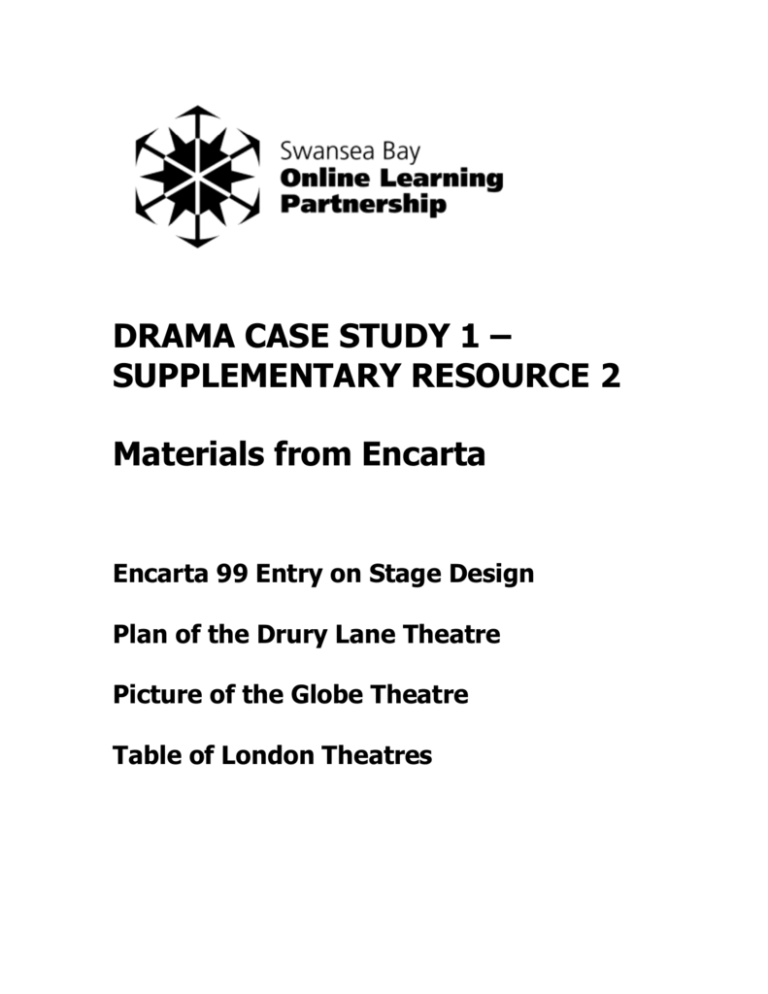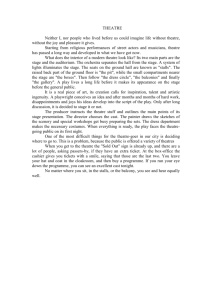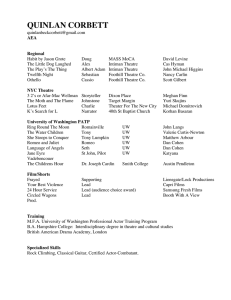
DRAMA CASE STUDY 1 –
SUPPLEMENTARY RESOURCE 2
Materials from Encarta
Encarta 99 Entry on Stage Design
Plan of the Drury Lane Theatre
Picture of the Globe Theatre
Table of London Theatres
ENCARTA 99 ENTRY ON THEATRE STAGE DESIGN
Theatre Stage Design, the function and development of scenery, costumes,
and sets for theatrical performances. The style of a stage design is largely
determined by the shape of the building in which it is set. The theatre of
classical Greece had little scenery. Plays were performed in large open-air
auditoria as part of a religious festival. There was a permanent setting used for
all plays. It was, basically, a wall with three entrances in it, the central one
being much larger than the other two. Vitruvius, writing about the later GraecoHellenic stage, described three-sided Periaktoi (towers) which could be
revolved to show different painted scenes. Other simple stage mechanics
included methods of representing flying gods. The plays, generally tragic,
concerned mythic heroes, with satyr-plays as comic relief. The performers, all
male, wore high head-dresses, strikingly modeled masks, and built-up boots,
making them much larger than life. Those playing in ribald farces were of more
natural height, and wore grotesque masks and padded costumes with
phalluses.
Street entertainment was a feature of medieval life that Renaissance princes in
the 15th century developed into major theatrical occasions. Visiting monarchs
were greeted with elaborate processions and with dramatic entertainments.
Great artists like Raphael, Leonardo da Vinci, and Giorgio Vasari devised
settings and costumes for courtly events as part of their normal duties, but by
the 16th century a new profession emerged, that of the stage designer
specializing in the designing and making of scenery and costumes. One of the
first was Baldassare Peruzzi, famous for his perspective settings. His pupil
Sebastano Serlio wrote a book about stage design in 1545 that had an
enormous influence. Included in his book were engravings of three basic
backgrounds suitable for drama as indicated by Vitruvius, a street, a palace,
and a pastoral scene. The designs followed the rules of parallel perspective
where objects appear to diminish towards a central vanishing point. He also
described how settings could be achieved by means of painted canvas
stretched over timber frames and how to change them swiftly.
It was not until the 17th century that permanent theatres were built. Until that
time temporary structures had been erected in palaces and courtyards. One of
the first was by Andrea Palladio in Vincenza, the Teatro Olympico. In imitation
of Roman theatres it had three arches in an elaborate façade, behind which
were receding streets in perspective. It was Aleotti's design for the Teatro
Farnese in Parma in 1618 that introduced the stage shape that was to last until
modern times. The three Roman arches were amalgamated into one big
proscenium arch surrounding the deep raked stage exactly like a picture frame.
A group of popular playwrights in London, Shakespeare and Marlowe among
them, were attracting large audiences to big galleried theatres open to the sky.
These had certain similarities to classical theatres; the stage setting was an
integral part of the building and served for every type of play, and
performances were in daylight. There was a central open space, and a raised
rectangular stage with a wall at the back, with access doors, and a balcony
above.
Architect to the Court of James I, Inigo Jones had traveled in Italy and was
much influenced by Palladio. The masques and entertainments that Jones
designed on his return were inspired by Italian stage techniques. There were
few scene-painters with a secure knowledge of perspective or engineers
experienced in complicated stage craft at the time; Jones was instrumental in
introducing these skills to England. As well as his many duties as Court
Architect, Jones produced over 30 masques. He used the full repertory of
known scene effects; scenery sliding in grooves, flying machines, and revolving
sets.
Both Louis XIII and Louis XIV of France loved taking part in ballets, elaborate
spectacles, opera-ballets, and masques, and many were staged in the palace
and the gardens at Versailles. Giacomo Torelli introduced the Italianate style
with his designs for the opera La Finta Pazza. Later in the 17th century a great
French designer, Jean Bérain eclipsed all Italian rivals.
When the monarchy was restored in England in 1660, Charles II sought to
revive the theatres and granted patents to William Davenant and Thomas
Killigrew to open playhouses. The first to open were roofed, with proscenium
stages, and lit by artificial light. Visually the Restoration carried on the tradition
of design introduced earlier by Inigo Jones.
The Italian style had meantime spread all over Europe, by means of engravings
of the settings and by the travels of the artists themselves; Santurini to
Munich, the Burnacini family to Vienna, and the Bibiena family, several
generations of which worked in Russia, Sweden, Germany, and Holland. They
designed the most grandiose of perspectives, using diagonals, so that the
buildings receded to invisible vanishing points way beyond the side wings.
These theatre design dynasties were a feature of the time. Designers generally
painted their designs themselves and the family helped in the paint studio. On
the Continent scenery was painted on the floor, in London it was painted
upright on tall moveable timber frames. The paint-frames took up much less
space and work was easier to see. Powder pigment mixed with distemper and
size was the medium; it was quick-drying, and flexible enough when dry to
enable canvas backcloths to be rolled up.
Not all theatrical companies needed elaborate settings. Touring companies
played on fit-up stages in town squares, villages, and barns. The most famous
were the commedia dell'arte troupes from northern Italy. Their set was simple,
a house, wings, and a backcloth of a street.
The 18th-century English theatre was more distinguished for the quality of its
actors than the play writing. David Garrick restored Shakespeare to popular
favour. His favourite designer was Phillipe de Loutherberg, a celebrated
landscape painter. His designs for Drury Lane Theatre were notable for their
fire, storm, and moonlight effects. Until the use of gaslight, lighting was a
problem. Candle light was difficult to control, and oil-lamps had a strong smell.
Smoke and fumes limited the amount of light available.
By the end of the 18th century theatres grew larger. Fly towers were built
above the stage so the cloths could be flown out of sight by means of hemp
lines and pulleys, and it was now possible to raise and lower the front curtain.
When Goethe produced Schiller's Wallensteins Lager at the Ducal Theatre at
Weimar, attempts were made to achieve correct period costumes. In Paris,
Talma played Nero in Classical robes; in Berlin, Karl Friederich Schinkel, a
dedicated Neo-Classic architect, designed frigidly-correct Gothic settings for Die
Jungfrau Von Orleans. Early in the new century when the Neo-Classical fashion
faded and Romanticism took over, the ballet came into its own with La Peri and
Giselle. Sanquirico's designs for the opera at La Scala, Milan, matched the
music of Bellini and Verdi. In England, massive Shakespearean productions by
Sir Henry Irving and Sir Herbert Beerbohm Tree presented increasingly heavy
and sumptuous Shakespearean revivals. The reaction was to come in the form
of naturalism, as represented in the plays written by Zola, Ibsen, Pinero, and
Chekhov. Their dramas took place in realistic rooms with doors that had locks
and door handles that turned. The box-set, with four walls and maybe a
ceiling, had arrived; and the proscenium framed an invisible wall.
New stage-craft was necessary to shift these solid settings. The lead in
mechanics came from Germany with the introduction of revolving stages,
complete floors that could slide away, and cyclorama skies lit by banks of
electric light. Using the new flexibility of light, Adolphe Appia in Germany and
Edward Craig in London favoured a more symbolic use of scenery with simple
three-dimensional shapes and vertical or horizontal movement.
Ballet design remained conservative until Diaghilev in Russia commissioned
modern painters to design for his Ballets Russes. When the Ballet visited Paris
in 1911, the work of Léon Bakst and Natalie Gontcharova astonished Western
Europe. These colourful designs influenced all areas of stage and costume
design. The musical theatre particularly benefited from the decorative work of
modern artists like Erte for the Folies Bergère, Joseph Urban, designer for the
Ziegfeld Follies in New York, and Claude Lovat-Fraser, whose sets and
costumes for The Beggar's Opera influenced a whole generation of British
designers, including Rex Whistler, Oliver Messel, and Carl Toms.
The early 20th century was remarkable for the amount of experimental design.
Germany was influenced by Expressionism; Russia, after the Revolution,
investigated Constructivism using scenery inspired by machinery, the French
avant-garde drama was inspired by the Dada Movement and Surrealism. It was
in America in the 1920s and 1930s that modern movements were synthesized
into a coherent style under the designers such as Robert Edmond Jones, Jo
Mielziner, Lee Simonson, Norman Bel Geddes, and Boris Aronson.
Theatre design was now being taught as a separate academic subject at
universities and art schools. After World War II, a German designer, Casper
Neher, became world famous for his work for the Berliner Ensemble under
Bertolt Brecht. His use of a restricted palette of greys and browns, and the
simplicity and plasticity of his sets had a revolutionary effect on designers
everywhere. Sean Kenny in London exploited the effects of moving heavy
scenery. Joseph Svoboda of Czechoslavakia took the use of projection to new
heights, and the Romantic tradition in opera design was continued in Italy with
the work of Salvatore Fiume, Nicola Benois, and Franco Zeffirelli. Designers and
lighting designers everywhere reacted positively to the new challenges and
opportunities presented by the recently built theatres such as those at
Stratford, Ontario, and Chichester.
A change in the method of transporting scenery has affected the structural
basis of scenic design. When scenery traveled by rail, the design units had to
fit into narrow goods trucks. The universal use of road and air transport means
that much larger, and more cumbersome pieces of scenery can be carried.
Above all, new raw materials have resulted in a different repertoire of scene
building. The use of plastics has had a major effect, resulting in large seamless
cycloramas that can also take rear projection. Moulded fibre glass and carved
polystyrene have replaced papier mâché for moulded objects. Transparent
plastics used by Ralph Koltai for As You Like It at the Old Vic in London in
1967. Vacuum-formed mouldings in PVC have resulted in a new degree of
simulated realism. The metal worker and the welder are now placed alongside
the carpenter as major craftsmen in stage techniques. The engineer also plays
an increasing part in achieving astonishing stage transformation, particularly in
the area of musicals, as demonstrated by Maria Bjornson's designs for The
Phantom of the Opera, and John Napier's for Miss Saigon and Sunset
Boulevard.
Contributed By:
Peter Rice1
1"Theatre Stage Design," Microsoft® Encarta® 99 Encyclopedia. © 1993-1998
Microsoft Corporation. All rights reserved.
Plan of the Drury Lane Theatre from Encarta 99
Picture of the Globe Theatre from Encarta
99
Table from Encarta 99 – West End Theatres
THEATRE
Adelphi 1
Albery (formerly New)
Aldwych
Ambassadors
Apollo
Apollo Victoria
Cambridge
Coliseum
Comedy
Criterion
Dominion
Donmar Warehouse
Drury Lane (Theatre Royal)
Duchess
Duke of York’s
Fortune
Garrick
Gielgud (formerly Globe)
Globe
Haymarket (Theatre Royal)2
Her Majesty’s3
Lyceum4
Lyric
National Theatre (Olivier, Lyttelton, Cottesloe)
New London
Old Vic
Open Air, Regent’s Park
Palace
Palladium
Phoenix
Piccadilly
Playhouse
Prince Edward (formerly Casino)
Prince of Wales
Queen’s
Royal Court
Royal Opera House
Royal Shakespeare Company (Barbican Theatre and The Pit)
St Martin’s
Savoy
Shaftesbury
Strand
Vaudeville
Victoria Palace
Westminster
Whitehall
Wyndham’s
FIRST BUILT
1858
1903
1905
1913
1901
1930
1930
1904
1881
1874
1929
1977
1663
1929
1892
1924
1889
1906
1996
1821
1891
1904
1888
1976
1973
1818
1933
1891
1910
1930
1928
1882
1930
1937
1907
1888
1732
1982
1916
1881
1911
1905
1870
1911
1924
1930
1899
NOTES ON THE TABLE
1 The Sans Pareil was the first theatre built on this site; it opened in 1806. It
was renamed the Adelphi in 1819, and rebuilt in 1858.
2.The Haymarket first opened in 1720 as the Little Theatre in the
Haymarket. It operated without a Royal Patent until 1766. The British
architect John Nash built the present theatre in 1821.
3 The original building opened in 1705
4 A theatre has existed on the site of the Lyceum since 1765. The current
theatre was built in1834, but was partly demolished and rebuilt in 1904. The
Lyceum reopened in 1996 after restoration.






